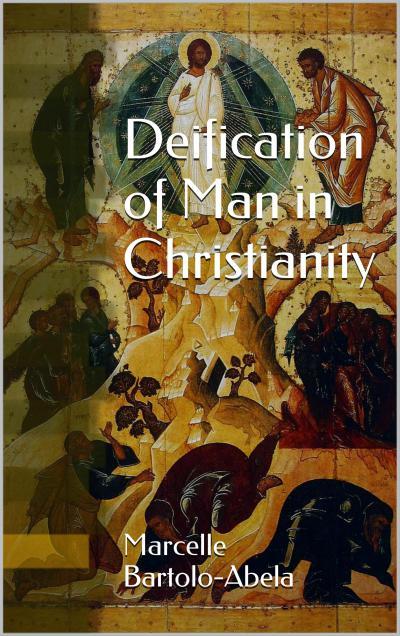
He who enjoys illumination is greater and receives more that he who only tastes, for he has within himself the assurance of his visions (Maximus the Confessor, Hom. 7,5-6, PG 34, col.527).
The Divine One purifies the man who desires Him: by this purification, He creates men of divine character, conversing as with friends with those who have attained this state; and uniting Himself as God with gods, and making Himself known to them perhaps to the same extent that He knows those who are known to Him. (Gregory of Nazianzus, Hom, XLV.3, PG XXXVI, 625C-628A).
Blessed are the pure in heart for they shall see God (Mt 5:8).
Chapter 4: ILLUMINATION AND DEIFICATION
Union with God became discontinuous after the fall because man became imperfect. Therefore, man can become deified and attain theoria – start seeing God – only insofar as the heart of his soul – called the nous – has first been healed by the trials of purification and reopened by the illumination which occurs through baptism in the Holy Spirit (Vlachos, 2005, 2010). The phrase ‘baptism in the Spirit’ as used herewith refers to it as historically understood throughout Christian tradition (e.g., Kontzevich, 1989). Basil of Caesarea said that souls who become “illuminated by the Holy Spirit transmit this grace to others and at the same time receive many gifts, including foreknowledge of the future, understanding of mysteries, apprehension of what is hidden, distribution of spiritual gifts, heavenly citizenship, a place in the chorus of angels, joy without end, abiding in God, being made like God, and, highest of all, being made god” (De Spir. Sanc, 9.23).
Illumination is thus “visible to those whose hearts have been purified, and . . . [is] utterly different from knowledge, though productive of it” (Gregory of Palamas, The Triads, I.3.3).
Deification is neither the process of simply acquiring the virtues as commonly understood, especially in Western Christianity, nor is it the end-aim of deification commonly known as participation in the Beatific Vision after death, for anyone who participates in the uncreated light, even if interruptedly at first due to lack of perfection, has started becoming deified; with deification itself being above all nature, virtue and knowledge. Cyril of Alexandria maintained that “Through knowledge and the gift of a divine vision, the Father leads those to whom He decides to give His divine grace towards the Son. When He receives them, the Son gives them life and to those whose own nature destined them to corruption He adds His own good grace, and pouring into them, as upon sparks of fire, the life-giving power of the Holy Spirit and transforming them utterly into immortality” (Commentary on the Gospel of John 4, [Jn 6.40], PG 73.545A).
Deification is thus none other than the sheer grace granted to man by God, through His ceaseless desire to make us like unto Himself. And when illumination occurs, with this contingent upon being embraced rather than rejected, man enters directly into the latter stages of deification because he becomes united with God.
Chapter 5: DEIFICATION AND THEORIA
Suddenly the Almighty reveals Himself in boundless humility. The vision floods our entire being and instinctively we bow in adoration . . . Prayer to this God of love and humility rises from the depths of our being . . . Brought from nothingness into life, man is drawn by His Creator into the fullness of divine life (Arch. Sophrony, 1997).
Only those found worthy of seeing the uncreated Light are able to gain true knowledge of God (Vlachos, 2010).
When deification occurs, it is not just the soul that takes part in theoria but also the body, for man sees the divine light and hears the voice of God after both his soul and the physical senses have been transformed by divine grace (Vlachos, 2010). Theoria is defined as seeing the glory of God through union with Him and deification. Unless man, therefore, has first been transfigured by the Spirit, the uncreated, divine light remains invisible. The full vision of the divinity in the divine light, in fact, is the mystery of the eighth day. But for those “who are worthy of it attain the sight of the ‘Kingdom of God come with power’ (Mk 9:1) in this life, as the three apostles saw it on Mount Tabor” (Lossky, 1967/1974, pp. 59-60).
The Eight Stages of Theoria
The only proof of a soul in good health is when it attains theoria (Gregory of Palamas).
According to Peter of Damascus (1782), the eight stages of theoria are as follows:
- First Stage – knowledge of life’s afflictions and temptations. True awareness of God’s blessing amidst our trials and tribulations;
- Second Stage – knowledge of God’s graces and beneficence toward us. True awareness of our sins and passions;
- Third Stage – knowledge of our sufferings, both before and after death;
- Fourth Stage – understanding the life of Jesus Christ before His Passion and Resurrection. True knowledge of what the ascetics, martyrs, and saints have said and done;
- Fifth Stage – knowledge of nature and its inner dynamics (logoi; Maximus the Confessor);
- Sixth Stage – knowledge of the uncreated, providential energy of God;
- Seventh Stage – understanding the angels;
- Eighth Stage – theoria of God, the vision of the uncreated Divine Light. Real knowledge of God and true theology.
Stages One to Three happen to those who are concerned with practical virtue (praxis) in the spiritual life. These stages are those of purification and they can be likened to spiritual convalescence (Vlachos, 2005). Stages Four to Eight happen to those whose nous has been cleansed and reopened through illumination. This second set of four stages can be likened to healing. Meanwhile, Stage Eight is related to the era of the eighth day whereby seeing God will be paradise for the pure, but the fire of hell for the impure (ibid.). Adam and Eve lived in Stage Eight before the fall.
Gregory of Palamas (1338/1983) subdivided the eighth stage of theoria into three additionally separate stages:
- The first stage of Stage Eight consists of the illumination of the nous, the heart or eye of the soul;
- The second stage of Stage Eight is theoria, the vision of God; and
- The third stage of Stage Eight consists of uninterrupted theoria, the constant vision of God.
Isaac the Syrian (2011) maintained that a soul has two ‘eyes’ with which to perceive. One eye comprehends that which is hidden in nature: apprehended theoria. The other eye beholds the actual glory of God, the divine light: unadulterated, received theoria. When unadulterated theoria occurs, images become imprinted upon the nous by the Holy Spirit (Basil of Caesarea, 363/1980) Who uses this governing faculty of man to announce the future (Gregory of Palamas, 1983).
Chapter 6: THE DIVINE LIGHT
As to him who mysteriously possesses and sees this light, he knows and possesses God in himself, no longer by analogy, but by a true contemplation, transcendent to all creatures, for he is never separated from the eternal glory (Gregory of Palamas, The Triads, II.3.16).
The divine light is a datum of mystical experience. It is the visible character of the divinity, of the energies in which God communicates Himself and reveals Himself to those who have purified their hearts (Gregory of Palamas in Lossky, 1967/1974, p. 58). The divine light “is not the essence of God, for that is inaccessible and incommunicable . . . Sometimes, it makes a man go out from the body or else, without separating him from the body, it elevates him to an ineffable height. At other times, it transforms the body and communicates its own splendor to it when, miraculously, the light which deifies the body becomes accessible to the bodily eyes . . . Sometimes the light ‘speaks’ clearly, as it were with ineffable words, to him who contemplates it. According to Gregory the Theologian, it descends from the elevated place where it dwells, so that He who in His own nature from eternity is neither visible to nor containable by any being may, in a certain measure, be contained by a created nature” (Gregory of Palamas, The Triads, II.3.9).
The uncreated light, therefore, is visible in theoria as the deifying gift of the Spirit, which is “not only visible to man but is participable by him, and in participating in it he is deified . . . Man is incapable of experiencing the uncreated light through his powers of perception. His eyes are blind to such a sight. But on receiving the power of the Holy Spirit, they are transformed and become capable of such vision” (Mantzaridis, 1984, pp. 99-100). The divine light of God, Who robes Himself in it as though clothed with a mantle, is not just the “object of vision, but it is also the power by which we see; it is neither a sensation nor an intellection, but is a spiritual power, distinct from all created cognitive faculties in its transcendence, and made present by grace in rational natures which have been purified” (Gregory of Palamas, The Triads, III.2.14). The uncreated light, in fact, clothes man with “boldness before God, the boon of speaking to Him as friend to Friend and of interceding on behalf of others . . . It is the robe and crown of glory which Adam lost in Eden . . . the presence now of the world to come, the foretaste and pledge of the eschaton, here in our midst, as it shall be on the last day” (Symeon the New Theologian, 1995).
The divine, uncreated light spoken about herewith is the same as that of the Transfiguration of Christ at Mount Tabor and which was seen by Peter, James and John (Mt 17:1-9, Mk 9:2-8; Lk 9:28-36; 2 P 1:16-18). It is “evaluatively placed on the same level with the light of the future Second Presence of Christ. It is the same light which will continuously envelop the worthy ones during the future life. It is the prelude of God’s glory. This is the light of the future age, which will be visible with the eyes of the heart” (Tselengides, 2011, p. 6).
To encounter the divine light entails the return of the human nature of man from its state of spiritual sickness through the darkness of sin (Untea, 2010), and within the process of deification, it is the reverse of the hypostatic union of Christ, albeit limited to our partaking of the divine energies (energeia) and not the essence of God (ousia). Meeting the divine light, therefore, is to encounter the “glory of that God who while remaining imparticipable, invisible and impalpable, becomes participable by His superessential power, and communicates Himself and shines forth and becomes in contemplation ‘One Spirit’ with those who meet Him with a pure heart, according to the most mystical and mysterious prayer . . . [Christ] addressed to His own Father: ‘Grant them that as I am in You, Father, and You in Me, so they too may be one in Us’ in truth” (Gregory of Palamas, The Triads, II.3.66). It is the same vision of the prophets, the patriarchs and that seen by Stephen while he was being stoned to death (Acts 7:54-60). It is “the invocation of the great God and Father, the symbol of the authentic and real adoption, according to the gift and grace of the Holy Spirit, thanks to the bestowal of which grace . . . [we] become and will remain the sons of God” (Gregory of Palamas, III.1.28).
Advertisements
